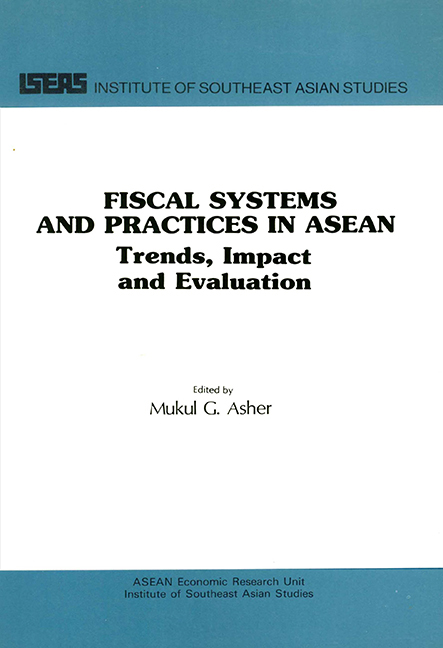Book contents
- Frontmatter
- Contents
- List of Tables
- List of Figures
- Acknowledgements
- 1 A Comparative Overview of ASEAN Fiscal Systems an Practices
- 2 Fiscal System and Practices in Indonesia
- 3 Fiscal System and Practices in Malaysia
- 4 Fiscal System and Practices in the Philippines
- 5 Fiscal System and Practices in Singapore
- 6 Fiscal System and Practices in Thailand
- THE EDITOR
4 - Fiscal System and Practices in the Philippines
Published online by Cambridge University Press: 21 October 2015
- Frontmatter
- Contents
- List of Tables
- List of Figures
- Acknowledgements
- 1 A Comparative Overview of ASEAN Fiscal Systems an Practices
- 2 Fiscal System and Practices in Indonesia
- 3 Fiscal System and Practices in Malaysia
- 4 Fiscal System and Practices in the Philippines
- 5 Fiscal System and Practices in Singapore
- 6 Fiscal System and Practices in Thailand
- THE EDITOR
Summary
Introduction
The Philippines is just beginning to emerge from the economic and political crisis experienced during the last few years of the Marcos administration. During the last two years of the Marcos administration, real GNP (gross national product) growth was negative, at-7.1 per cent in 1984 and-4.2 per cent in 1985 (Tan 1988, p. 218). With the advent of the Aquino administration in February 1986, there has been a modest economic recovery, particularly when the growth rate of real GDP (gross domestic product) or GNP is used as an indicator. According to the same source, GNP grew at a rate of 1.5 per cent in 1986 and 5.1 per cent in 1987. The real GDP is estimated to have grown at a rate of 6.8 per cent in 1988 (Business Times [Singapore], 10 February 1989). While some doubts persist, there appears to be a consensus, particularly among the business oriented publications, that the Philippines will be able to sustain a moderate rate of growth over the next few years. According to a recent study, real GDP of the Philippines is expected to grow at a rate of between 4.3 and 4.6 per cent per year during the 1988-93 period (Hodgkinson 1988, pp. 110-11).
This paper attempts an analysis of the fiscal system and practices in the Philippines, focusing on the period since 1975. Several factors hampering such an analysis should, however, be noted at the outset. First, the fiscal structures and procedures in the Philippines are among the most complex (Cheetham and Hawkins 1976, p. 390). This has been compounded by the frequent changes. Secondly, there are unusually wide divergences between the over elaborate formal fiscal structures and practices and their actual implementation. Thirdly, the fiscal data exhibit wide unexplained divergences even when official publications are used. As a result, the extent of their reliability is not always clear. Fourthly, the lags in the availability of data are unusually long.
Historically, the Philippines has had a centralized government and therefore, there has been little delegation of powers to the provinces and the local governments (Cheetham and Hawkins 1976, p. 390).
Information
- Type
- Chapter
- Information
- Fiscal System and Practices in ASEANTrends, Impact and Evaluation, pp. 103 - 130Publisher: ISEAS–Yusof Ishak InstitutePrint publication year: 1989
